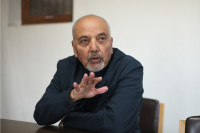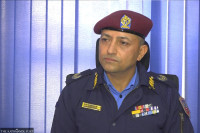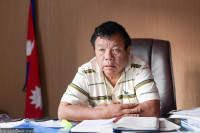Interviews
Valerie Julliand: The relationship between Nepal and the UN is of mutual respect and collaboration
The outgoing UN resident coordinator on the Covid-19, human rights situation, transitional justice and her tenure in Nepal.
Binod Ghimire
The United Nations has been Nepal’s long-standing development partner. It has played a proactive role across sectors and especially during humanitarian crises. In June 2016, when the country was at its preliminary phase of post-earthquake recovery, Valerie Julliand took charge as the UN resident coordinator in Nepal. As Julliand wraps up her four-year tenure, the world has found itself deep in a pandemic, including in Nepal, where cases are currently peaking. The Post’s Binod Ghimire had an email interview with the outgoing resident coordinator to learn about her engagement with power corridors in the country and Nepal and the United Nations’ relationship dynamics.
Excerpts:
How would you describe the relationship between the United Nations and the Government of Nepal during your tenure? We have heard of some reservations by the government in some of the UN activities.
When I first arrived in Nepal, the country was recovering and reconstructing after the 2015 earthquakes – a feat that would be daunting and challenging for any country. As I leave, Nepal faces the consequences of the COVID-19 pandemic, both in terms of health and broader socio-economic recovery. Throughout this, in crisis and the broader development agenda, the UN has stood by the government’s side and supported Nepal’s people. As the UN, we work with and through the government to assist people. During my tenure, we signed a five-year partnership agreement (UNDAF 2018-2022). We supported the reconstruction process, the 2017 response to the floods, the hosting of the Scaling Up Nutrition Global Gathering last year, the preparedness and response to COVID-19, the federalization process, and not least, the progress towards the Sustainable Development Goals. Now more than ever, in the COVID-19 context, we need to remember that we cannot take the progress made on the Sustainable and Millenium Development Goals for granted. Still, we need real change in our societies, policies, and economies to ensure that the progress is not lost.
I would describe the relationship between Nepal and the UN as one of mutual respect and collaboration. Nepal is a member state of the UN and one that is committed to multilateralism. The UN’s role is to support the government and ensure that member states respect and meet their international conventions and treaties’ commitments. And as it should be in close collaboration, we also raise and discuss difficult issues and find solutions, which we have done. That is the foundation of an honest and constructive partnership. It is how the UN works in all countries, and Nepal is no different.
The Covid-19 threat is not going away anytime soon. What is your assessment of Nepal’s response to the pandemic, and how is the UN working with the government?
Covid-19 has challenged most countries in the world; it has spared no one. Health systems have been stretched, and given that the virus has been an unknown entity, all countries have had to decide the most appropriate action given their specific situation.
The UN’s COVID-19 health response is led by the World Health Organisation, which has a long-standing collaboration with the Ministry of Health and Population. It provides technical support in several areas, such as forecasting needed supplies, helping out in epidemiology and data analysis to understand the epidemic and where it is going, and writing guidelines, training, and communication.
The overall UN response, under my leadership, covers many other areas beyond health; I could name shelter, protection, nutrition, education, food, water and sanitation, social and economic recovery. We support the government with a broad range of activities.
It is still difficult to measure how Nepal is dealing with the crisis as we are still in the middle of the crisis, and cases are rising again. It is a moving target. Governments worldwide are learning how to continually update their responses and drawing lessons from their own and other countries' practices. They have to integrate public health, security, governance, and socio-economic efforts. They also have to keep abreast of the evolving science of the virus and sociology of how the population can mitigate and prevent spread while looking to support the most vulnerable. Another global lesson is that governments are only one part of the equation; the private sector, the media, civil society, and the public need to do their share.
Nepal was quick to announce the lockdown, and when people started crossing the border from India, it was quick to quarantine them. This measure contributed to contain the virus in the first phase. The Health Ministry has prepared hospitals to be better equipped and get more supplies, which must continue. As cases are picking up the second phase, we hope that the training of staff and supplies can keep pace.
In this context, there is much to commend in the government’s response, and the job is not finished – and as we can see in other countries, there can be reoccurrences requiring specific interventions. A critical aspect that needs attention is contact tracing. It is a crucial area where the government can do much more. The local and provincial governments must also play their role in this and other socio-economic areas.
I think it is also important to highlight what people can do to contain the virus’s spread. We need to maintain physical distance, wash hands, and wear facemasks. There is no room for complacency. And while we prepare for the worst-case scenario, we still hope for the best.
Your tenure started just as Nepal was beginning its post-earthquake recovery. What is your assessment of the reconstruction efforts? How will the UN ensure that reconstruction works will not be delayed?
Immediately after the earthquakes, the UN system provided humanitarian support. We also worked closely with the government on the Post Disaster Needs Assessment and the Post Disaster Recovery Framework to ensure rebuilding in a better and safer manner so that new structures are resilient enough to face future shocks.
The recovery and reconstruction of such magnitude earthquakes would be challenging for any country. The topography of Nepal makes it incredibly challenging to reach the hardest-hit areas. As such, the government and civil society have been doing their level-best to reconstruct after the earthquake; they chose the model of owner-driven reconstruction of private houses to ensure that there was momentum and people were given the opportunity to get their homes back. In such a process, there will, in hindsight, always be things that one would do differently. For example, while it is understandable considering the extent of the crisis, the government took a uniform approach of support to affected households, essentially that of ‘one size fits all,’ it soon showed its limitations due to Nepal’s inequalities and disparities. Here, our role as the UN was to highlight this and support the government in readjusting to meet the specific and diversified needs of particular segments of the population, such as female-headed households, people with disabilities, landless people, and those without title deeds to their houses, etc.
The UN has been working on many different issues in the reconstruction, and in partnership with the National Reconstruction Authority, for example, assessing landslide risk of settlements, providing support for reconstruction to marginalized households, reestablishing water sources, restoring trails and trekking routes, building temporary learning centers, and reconstructing schools and cultural heritage sites. We also collected feedback from affected communities to ensure that they reached people and met their needs. The information we received led us to adjust our recovery approach accordingly.
The country must take the past lessons and enforce the laws and policies put in place after the earthquake, whether concerning the construction of seismic resistant housing or not building roads in landslide-prone areas. I hope that the earthquake showed that preparing for disasters is not a choice; we have to do it. Having a Disaster Risk Management policy and strategic action plans at both provincial and local levels will help Nepal mitigate, prepare, respond to, and recover from any disaster.
You have traveled extensively across the country and interacted with provincial and local governments. How do you assess the relationship between the government’s three tiers, five years since the Constitution’s promulgation?
The promulgation of the Constitution took place before I arrived, though there was still the requirement to amend laws and acts to ensure that they were in line with the Constitution. It was estimated that the parliament would have to pass laws in as many as 138 areas and amend around 315 laws to implement the Constitution, which continues to be a big undertaking. Laws, acts, and regulations are one thing, though for these to have meaning, they must also be implemented – ensuring that everyone is equal in front of the law and that rule of law is a key tenet of the country.
In the last few years, I have seen a step-change in governance in Nepal. With local and provincial elections taking place, the number of women and Dalits among locally elected officials has increased considerably, and provinces and local municipalities’ formation was completed. This restructuring would be a significant undertaking for any country; Nepal has adopted a pragmatic approach. While the practical rolling out of federal structures – laws, plans, budgets, and capacity – will take time and continues to pose challenges, I am encouraged by the engagement I have seen at the local level. My discussions on good governance with local and provincial governments and the federal level have been among the most interesting and satisfying aspects of my work. We have also been encouraged to see the enthusiasm for the localization of the Sustainable Development Goals as a guiding light for development planning and measurement.
The relationship between the three tiers of Government is a work in progress. I hope that the provincial and local authorities are soon provided with the resources to exercise their powers as enshrined in the constitution. As I said earlier on, such an important transition requires many adjustments. Beyond the practical changes in laws, structures, staffing, etc., the most difficult one is the mentality. Essentially, this transition requires a shift in norms, in our way of doing this. Human beings are creatures of habit, and old habits die hard. But nothing is insurmountable with dialogue and consultation.
Nepal is among the few countries that ensure a good representation of women in the state organs. Still, there are concerns that the representation is mostly ceremonial, and they don’t have much say in policy-making. What are your thoughts on this?
Nepal heralded a welcome development with the local and provincial elections held in 2017. The election broke the historical barrier to women’s representation in local governance — 14,000 women (of which 6,500 Dalits) hold 41 percent of all local elected positions. I cannot make a sweeping statement about 14,000 women who are new to the roles and have started to find their place in the federal system.
Another historical example is that of the deputy mayors, almost all of whom are women. Hopefully, in the next elections, they’ll become the mayors; this would profoundly change Nepal’s needs. The UN has supported local governments to receive training on Gender Responsive Budgeting (GRB) and its localization through a GRB software application with the Local Development Training Academy. The UN also assisted the Election Commission of Nepal to develop a gender equality monitoring tool for local elections, supported the campaigns of women’s groups, and provided training to women focusing on leadership and political participation.
Whether elected women are less engaged in policy-making may not be the best way to approach the question. We could turn the question around and ask whether the male elected representatives are doing all the policy-making they are meant to? To achieve equality and meaningful participation, we need everybody’s efforts, commitment, and endeavors, not only female elected representatives. Men have not been elected to represent men only. Why should they do policies benefiting only men then? Again, while the change in numbers of women in elected office is momentous, what becomes essential now is whether they will be provided with an environment that allows them to do their work well. Their voice must hold the same weight as their male counterparts; their expertise and experience are respected.
What is your observation when it comes to human rights in Nepal?
Nepal has made significant progress on the human rights front, with a historical legal framework emerging in the last five years. Nepal promulgated its Constitution in 2015 that provides civil, cultural, economic, political, and social rights. The parliament then enacted laws to enforce the fundamental rights guaranteed in the Constitution, an essential step to implement and realize them. The state restructuring and legal reform process have been guided by Nepal’s international human rights commitments in relation to non-discrimination, gender equality, and social justice. Nepal’s election to the Human Rights Council and its continued commitment to fundamental rights and freedoms are very welcomed.
While moving forward with so many positive aspects, there are some areas that are recognized as still needing reform, to respect and enforce the human rights conventions that Nepal is a party to. Some examples include the amendment bill on the National Human Rights Commission Act that is not yet in conformity with the Paris Principle; the Media Council bill currently violates the freedom of expression/opinion; and the Special Service bill that currently violates rights to privacy. These need to be amended to protect the fundamental rights of the people. The non-implementation of recommendations made by the National Human Rights Commission and the Supreme Court is equally of concern.
We welcome the historic representation of women and marginalized groups at various levels of the government and legislation that criminalizes gender-based violence, caste-based discrimination, and violation of indigenous peoples’ rights. However, while necessary laws are in place, caste-based discrimination and gender-based violence, including sexual violence, continue with impunity. It is very important to assess the gaps in the implementation of these laws and develop necessary measures/mechanisms to ensure effective remedy and access to justice for violations or breaches. I want to emphasize that women’s rights are human rights, and as long as half of the population does not enjoy the same rights and access as men, Nepal will not be able to achieve the development and equality it strives to achieve.
The UN stands ready to provide the necessary support to Nepal’s government to implement international conventions to address these outstanding issues.
You showed a keen interest in transitional justice. In your opinion, what is responsible for the delay in providing justice to the victims of the decade-long armed conflict in Nepal?
The victims of the armed conflict in Nepal are still waiting for remedy, reparation, and redress to their loss. Many victims (approx. 65,000) have registered their complaints to both the mechanisms — Truth and Reconciliation Commission and Commission on Investigation of Enforced Disappeared Persons (CIEDP). It has been more than a decade since the legislation governing the transitional justice process has been discussed or disputed- but a satisfactory text is still not agreed.
For a transitional justice process to advance on a sustainable and long-lasting path, and for the armed conflict to be relegated to history, a victim-centric approach is a must. Victims must be involved in the legislation framing judicial and non-judicial measures for truth-seeking, and effective and timely reparation. They are the best advocates for guarantees of non-repetition, and they must be heard on the standards of criminal accountability for severe violations of human rights. Reconciliation also takes place through memorialization efforts that document and acknowledge the experiences of victims. The conflict victims have also demanded a victim-centric approach, and the amendment of the Enforced Disappearance Enquiry, Truth and Reconciliation Act should be done with their meaningful participation. Truth-seeking, investigations and criminal trials, reparation, and memorialization should all go hand-in-hand. All of this requires the sincere and genuine political will of all involved, and concrete actions, not only words.
As you wrap up your tenure, what memories are you taking from Nepal?
Nowadays, cities all over the world look more or less the same. You will find the same things. But Nepal has kept its uniqueness. It has preserved its unique culture. Nepal is a treasure box and still has so much potential. I find that people here are very hard working. If everyone has equal opportunities, then I believe that Nepal’s economy can flourish in the regional and global economy. I have also tremendously enjoyed the travels I have made in the country, from the Far-West to the East, and from the Tarai to the high mountains; it all has its unique charm.
I have found Nepal’s people to be hospitable, friendly, and kind, and I seriously don’t know where the inherent kindness that Nepali people have comes from. If I knew, I would implement it as a recipe everywhere else. If I were to rank people on kindness, I would rank the Nepali people first.




 12.12°C Kathmandu
12.12°C Kathmandu












